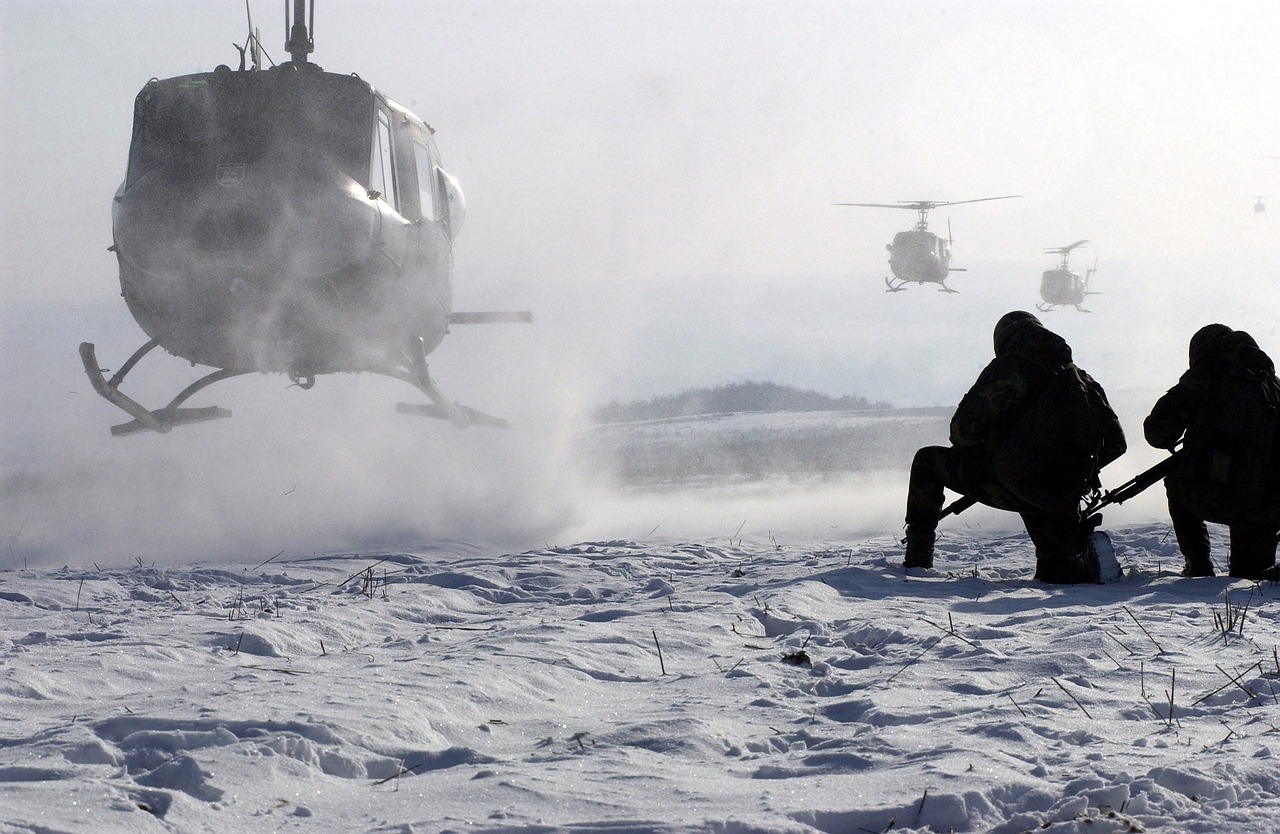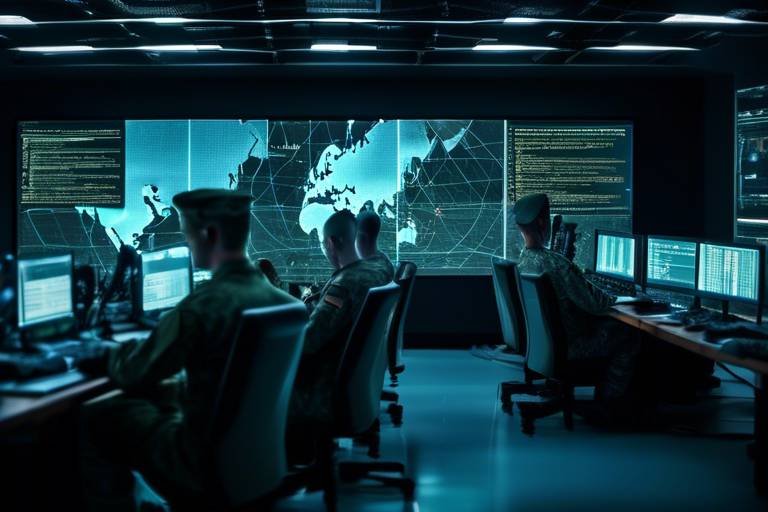AI in Anti-Aircraft Systems - Defending Against Emerging Threats
In an age where aerial threats are becoming more sophisticated and unpredictable, the integration of artificial intelligence (AI) into anti-aircraft systems is not just a trend; it's a necessity. Picture this: a world where machines can analyze vast amounts of data in real-time, making split-second decisions that could mean the difference between safety and disaster. This is the promise of AI in defense, particularly in countering emerging aerial threats. As we delve into this topic, we'll explore how AI enhances the capabilities of anti-aircraft systems, the challenges they face, and the incredible potential that lies ahead.
Artificial intelligence is revolutionizing defense strategies across the globe. By leveraging machine learning and data analytics, AI enhances decision-making processes, allowing anti-aircraft systems to respond more effectively to threats. Imagine a scenario where a system can predict an incoming missile's trajectory by analyzing previous flight patterns and environmental conditions. This level of precision not only improves the accuracy of interceptions but also streamlines operations, saving precious time and resources. The real-time processing capabilities of AI mean that systems can adapt to changing conditions faster than any human operator, ensuring a more robust defense against the ever-evolving threat landscape.
The aerial threat environment is rapidly evolving, with various new challenges emerging. Today's anti-aircraft systems must contend with a range of threats, including drones, hypersonic missiles, and other advanced aerial vehicles. Each of these presents unique challenges that require innovative solutions. For instance, drones have become a popular tool in modern warfare, utilized for reconnaissance and direct attacks, while hypersonic missiles can travel at speeds exceeding Mach 5, making them incredibly difficult to intercept. Understanding these threats is crucial for developing effective countermeasures.
Drones are increasingly used in warfare, presenting a multifaceted challenge for anti-aircraft systems. These unmanned aerial vehicles (UAVs) can be deployed in swarms, making them difficult to detect and neutralize. AI plays a pivotal role in addressing these challenges, enabling systems to identify, track, and engage drones more effectively. By employing advanced algorithms, AI can distinguish between friendly aircraft and potential threats, reducing the risk of friendly fire and ensuring that responses are timely and accurate.
Various countermeasures exist to combat drone threats, including electronic warfare and kinetic interceptors. However, the integration of AI-driven technologies significantly enhances the effectiveness of these countermeasures. AI systems can analyze incoming data from multiple sensors, providing operators with a comprehensive view of the battlefield. This capability allows for rapid decision-making and deployment of countermeasures, ensuring that threats are neutralized before they can cause harm.
Integrating AI with legacy systems is crucial for enhancing operational capabilities. Many military systems have been in place for decades, and retrofitting them with AI technology poses both challenges and opportunities. The key lies in developing strategies that allow for seamless integration without compromising the reliability of existing systems. This might involve creating hybrid systems that combine traditional methods with AI-driven enhancements, thus ensuring a smooth transition into a more automated future.
Hypersonic missiles represent a significant challenge for defense systems due to their incredible speed and maneuverability. Traditional radar systems struggle to detect these fast-moving threats in time. However, AI can improve detection and interception strategies by utilizing predictive analytics to anticipate missile trajectories and optimize response strategies. By analyzing data from various sources, AI can provide operators with actionable insights, enhancing their ability to respond effectively to these modern threats.
AI offers numerous advantages in anti-aircraft systems, transforming how we approach aerial defense. Some key benefits include:
- Increased accuracy: AI algorithms enhance target recognition and classification, ensuring that threats are identified correctly.
- Faster response times: With real-time data processing, AI can significantly reduce the time between threat detection and response.
- Improved resource management: AI optimizes the allocation of resources, ensuring that defense systems operate efficiently.
Accurate target recognition is vital in modern warfare. AI algorithms significantly enhance the ability to identify and classify aerial threats, reducing the risk of friendly fire and improving overall operational efficiency. By employing machine learning techniques, these systems can learn from past engagements, continually refining their recognition capabilities and adapting to new threat profiles.
The rise of autonomous systems is reshaping the defense landscape. AI-driven autonomous anti-aircraft systems can operate with minimal human intervention, allowing for rapid engagement of threats. However, this also raises ethical considerations regarding the use of autonomous weapons in military operations. As we move forward, it's essential to establish guidelines governing the deployment of these systems to ensure they are used responsibly and effectively.
Despite its advantages, the integration of AI into anti-aircraft systems faces several challenges. Technological limitations, cybersecurity risks, and the need for human oversight in critical defense operations are significant concerns that must be addressed. For instance, while AI can process data quickly, it is not infallible and requires robust human oversight to ensure that decisions made by these systems align with ethical standards and operational protocols.
AI systems are vulnerable to cyber threats, making cybersecurity a top priority. Protecting AI-driven anti-aircraft systems from malicious attacks is crucial to maintaining operational integrity. This involves implementing stringent cybersecurity measures and continuously monitoring systems for potential vulnerabilities. Without proper safeguards, the very technology designed to protect us could become a target itself.
The use of AI in military applications raises important ethical questions. As we develop autonomous weapons, it's vital to consider the moral implications of allowing machines to make life-and-death decisions. Establishing guidelines and frameworks for the responsible use of AI in military operations is essential to ensure that these technologies are deployed ethically and effectively.
- How does AI improve the accuracy of anti-aircraft systems? AI enhances target recognition and classification, allowing systems to identify threats more accurately and respond appropriately.
- What are the primary challenges in integrating AI with existing defense systems? Key challenges include technological limitations, cybersecurity risks, and the need for human oversight.
- What ethical concerns are associated with autonomous weapons? The primary concerns revolve around the moral implications of allowing machines to make decisions regarding life and death.

Understanding AI in Defense
Artificial intelligence (AI) is not just a buzzword; it’s a game-changer in the realm of defense strategies. Imagine a world where military systems can think, learn, and adapt in real-time. This is the promise that AI holds for anti-aircraft systems. By integrating advanced algorithms and machine learning models, these systems can enhance their decision-making processes significantly. But how exactly does this work? Well, AI can analyze vast amounts of data from various sources, such as radar and satellite imagery, to identify potential threats faster than any human operator.
One of the most exciting aspects of AI in defense is its ability to improve the accuracy and efficiency of anti-aircraft systems. Think of it as having a supercharged brain that can process information at lightning speed. For instance, when a potential aerial threat is detected, AI systems can quickly assess the situation, evaluate the threat level, and determine the best course of action. This not only speeds up response times but also minimizes the chances of errors, which can be catastrophic in a military context.
Moreover, AI can learn from past engagements. Each time a system encounters a new type of threat, it can adapt its algorithms to better handle similar situations in the future. This continuous learning process is akin to how humans improve their skills through experience. In essence, AI acts as a force multiplier for defense forces, allowing them to respond to emerging threats with unprecedented precision.
However, it’s not just about speed and accuracy. AI can also enhance situational awareness by integrating data from multiple platforms. For example, consider a scenario where multiple anti-aircraft systems are deployed across a wide area. AI can aggregate data from these systems, providing a comprehensive view of the airspace and enabling coordinated responses to threats. This level of integration is crucial in today’s complex battlefield environments.
In summary, the integration of AI into anti-aircraft systems is transforming the way military forces defend against aerial threats. With enhanced decision-making capabilities, improved accuracy, and greater situational awareness, AI is paving the way for a new era in defense technology. As we continue to explore the capabilities of AI in this field, it’s essential to remain vigilant about the challenges and ethical considerations that accompany this powerful technology.
- What role does AI play in anti-aircraft systems?
AI enhances decision-making, accuracy, and efficiency, allowing for faster and more precise responses to aerial threats. - How does AI improve target recognition?
AI algorithms analyze data to identify and classify targets, reducing the risk of friendly fire and improving operational efficiency. - What are the ethical implications of using AI in defense?
The deployment of autonomous weapons raises moral questions that necessitate guidelines to ensure responsible use in military operations. - Are there cybersecurity risks associated with AI in defense?
Yes, AI systems can be vulnerable to cyber threats, making cybersecurity measures essential to protect operational integrity.

Current Threat Landscape
The aerial threat environment is evolving at an unprecedented pace, and it's crucial for defense systems to adapt accordingly. Gone are the days when traditional aircraft were the primary concern; today, we face a myriad of emerging threats that challenge the capabilities of anti-aircraft systems. The landscape is now dominated by advanced technologies such as drones, hypersonic missiles, and other sophisticated aerial vehicles that require innovative solutions to counter effectively.
Firstly, let's talk about drones. These unmanned aerial vehicles (UAVs) have become a game-changer in modern warfare. Their ability to fly at low altitudes, coupled with stealth technology, makes them difficult to detect and intercept. Drones can be deployed for various purposes, including surveillance, reconnaissance, and even direct attacks, which complicates the defense strategy. As they become more sophisticated, the need for AI-driven detection and neutralization systems becomes more pressing.
Next up are hypersonic missiles. These projectiles travel at speeds exceeding Mach 5, making them incredibly challenging to track and intercept. Traditional radar systems often struggle to keep pace with such fast-moving threats, leading to a critical gap in defense capabilities. Here, AI can play a pivotal role by enhancing detection algorithms and improving interception strategies. The integration of machine learning can help predict the trajectory of these missiles, allowing for timely and effective responses.
In addition to drones and hypersonic missiles, we also face threats from advanced aerial vehicles, including stealth bombers and cruise missiles. These technologies are designed to evade detection and can operate in a variety of environments, further complicating the defense landscape. The rapid evolution of these threats necessitates a multi-layered defense strategy that leverages AI for enhanced situational awareness and decision-making.
To summarize, the current threat landscape is marked by:
- Drones: Increasingly used for surveillance and attacks.
- Hypersonic Missiles: Fast-moving threats that challenge traditional detection systems.
- Advanced Aerial Vehicles: Stealth technology complicates tracking and interception.
As we delve deeper into these challenges, it becomes evident that integrating AI into anti-aircraft systems is not just an option; it’s a necessity. The ability to analyze vast amounts of data in real-time, make split-second decisions, and adapt to new threats will determine the effectiveness of our defense strategies. In the face of these emerging threats, the question remains: are we ready to embrace the future of aerial defense?
- What are the main threats to anti-aircraft systems today? The primary threats include drones, hypersonic missiles, and advanced aerial vehicles, all of which require innovative defense strategies.
- How does AI enhance anti-aircraft systems? AI improves decision-making, enhances target recognition, and enables faster response times against aerial threats.
- What challenges do anti-aircraft systems face? Key challenges include technological limitations, cybersecurity risks, and the need for human oversight to ensure operational integrity.

Drone Warfare
In the modern battlefield, has emerged as a game changer, altering the dynamics of aerial conflict. Drones, or unmanned aerial vehicles (UAVs), are increasingly being utilized not just for surveillance but also for direct attacks. This shift represents a significant challenge for traditional anti-aircraft systems, which were designed to counter conventional threats like fighter jets and bombers. The agility and low cost of drones make them an attractive option for both state and non-state actors, complicating the defense landscape.
One of the biggest hurdles in addressing the drone threat is their sheer diversity. Drones come in various shapes and sizes, from small commercial quadcopters to large military-grade UAVs capable of carrying significant payloads. This variation requires anti-aircraft systems to be adaptable and capable of identifying and responding to a wide range of aerial threats. For instance, a small drone may be used for reconnaissance, while a larger drone could be armed with explosives, posing a direct threat to ground targets.
Moreover, the stealth capabilities of many drones complicate detection efforts. Unlike traditional aircraft, drones can fly at lower altitudes and may be designed to minimize radar signatures, making them harder to spot. This is where artificial intelligence plays a crucial role. By leveraging advanced algorithms and machine learning, AI can enhance detection capabilities, allowing anti-aircraft systems to identify drones more effectively. These systems can analyze data from various sensors in real-time, improving the accuracy of target recognition and classification.
Another significant challenge is the swarm tactics employed by adversaries. Groups of drones can be deployed simultaneously, overwhelming traditional defense systems. In such scenarios, a single anti-aircraft system may struggle to keep up with multiple threats, leading to potential failures in defense. AI can help mitigate this risk by coordinating responses across multiple platforms, enabling a more unified and strategic approach to defense. For example, AI can prioritize threats based on their trajectory and potential impact, allowing operators to focus their resources where they are needed most.
To effectively counter drone warfare, anti-aircraft systems must not only improve their detection capabilities but also develop effective countermeasures. This includes deploying electronic warfare tactics that can disrupt drone communications or employing kinetic solutions to neutralize threats. The integration of AI into these countermeasure systems can enhance their effectiveness, allowing for rapid responses to drone incursions and minimizing the risk of collateral damage.
In conclusion, the rise of drone warfare presents both challenges and opportunities for anti-aircraft systems. By embracing artificial intelligence and adapting to the evolving threat landscape, defense forces can enhance their capabilities and improve their chances of effectively countering these modern aerial threats. As we move forward, the integration of AI in anti-aircraft systems will be crucial in staying one step ahead of adversaries who seek to exploit the vulnerabilities of traditional defense mechanisms.
- What types of drones are commonly used in warfare? Drones vary widely, from small consumer models for reconnaissance to large military UAVs equipped with weapons.
- How can AI improve drone detection? AI enhances detection by analyzing data from multiple sensors in real-time, improving target recognition and classification.
- What are swarm tactics in drone warfare? Swarm tactics involve deploying multiple drones simultaneously to overwhelm defense systems, making them difficult to counter.
- What countermeasures are effective against drones? Effective countermeasures include electronic warfare, which disrupts communications, and kinetic solutions that physically neutralize threats.

Countermeasures Against Drones
As drones become more prevalent in modern warfare, the need for effective countermeasures has never been more pressing. These unmanned aerial vehicles (UAVs) can be used for reconnaissance, surveillance, and even offensive strikes, making them a formidable threat. However, integrating artificial intelligence into anti-aircraft systems offers a promising solution to neutralize these aerial intruders.
One of the most effective countermeasures against drones is the use of AI-driven detection systems. These systems leverage advanced algorithms to analyze data from various sensors, including radar and optical cameras, to identify and track drone movements in real-time. By employing machine learning techniques, these systems can continuously improve their accuracy, learning to distinguish between friendly and hostile drones, thus reducing the risk of false alarms. Imagine having a vigilant guardian that learns and adapts, ensuring that every potential threat is assessed with precision.
In addition to detection, AI plays a crucial role in the interception of drones. Once a drone is identified as a threat, AI systems can quickly evaluate the best course of action, whether it be deploying a counter-drone system, launching a missile, or using electronic warfare tactics to disrupt the drone's control signals. This rapid decision-making capability is essential in a world where drone speeds and capabilities are continually evolving.
Moreover, jammer technology represents another layer of defense against drone threats. Jammers can interfere with the communication signals between the drone and its operator, effectively rendering the drone useless. AI enhances these systems by optimizing the jamming frequency and intensity based on the specific drone technology being targeted. This dynamic approach ensures that countermeasures are not only effective but also adaptable to various drone types.
To illustrate the effectiveness of these countermeasures, consider the following table that summarizes some of the most common AI-driven technologies used in drone defense:
| Technology | Description | Advantages |
|---|---|---|
| AI Detection Systems | Utilizes radar and cameras to identify drones. | High accuracy, low false positives. |
| Counter-Drone Missiles | Missiles designed to intercept and destroy hostile drones. | Fast response, precision targeting. |
| Electronic Jammers | Disrupts communication between drones and operators. | Non-kinetic solution, reduces collateral damage. |
While these technologies are promising, it’s important to recognize that they are not foolproof. The evolving nature of drone technology means that countermeasures must continuously adapt. AI can help in this regard by analyzing patterns in drone usage and developing predictive models to anticipate future threats. As we look to the future, the integration of AI in anti-aircraft systems will be pivotal in maintaining airspace security.
- What types of drones pose the biggest threats? Drones used for reconnaissance, armed attacks, and swarming tactics are considered significant threats due to their versatility and low cost.
- How can AI improve drone detection? AI can enhance detection through machine learning algorithms that analyze sensor data to identify drone signatures, improving accuracy over time.
- Are there ethical concerns with using AI in counter-drone systems? Yes, the use of AI raises ethical questions, particularly regarding autonomous decision-making in military operations.
- What is the role of human oversight in AI-driven systems? Human oversight is crucial to ensure that AI systems operate within ethical boundaries and make decisions aligned with military objectives.

Integration with Existing Systems
Integrating artificial intelligence with existing anti-aircraft systems is not just a technical challenge; it's a strategic necessity. As aerial threats evolve, the need for systems that can adapt and respond in real-time has never been more critical. However, merging cutting-edge AI technologies with legacy systems can feel like trying to fit a square peg in a round hole. The complexities of this integration can be daunting, but with the right approach, the benefits can far outweigh the challenges.
One of the primary hurdles in this integration process is the compatibility of old and new technologies. Many military systems were designed decades ago, relying on outdated software and hardware that may not easily communicate with modern AI solutions. To address this, defense contractors and military strategists are exploring various upgrade paths for these legacy systems. This often involves creating middleware that serves as a bridge, allowing AI algorithms to interact with existing sensor networks and command systems seamlessly. By doing so, we can enhance the operational capabilities of older systems without the need for complete overhauls.
Moreover, the integration of AI must consider the user interface and operational protocols. Operators accustomed to traditional systems may find it challenging to adapt to AI-driven interfaces. Therefore, comprehensive training programs are essential. These programs should not only focus on how to use the new systems but also on understanding the underlying AI processes that drive decision-making. By fostering a culture of collaboration between human operators and AI systems, we can improve situational awareness and response times significantly.
Additionally, the integration process must address data security and cybersecurity concerns. As we connect older systems to AI networks, we inadvertently expose them to potential cyber threats. Implementing robust cybersecurity measures is paramount to protecting sensitive military data and ensuring that AI systems function correctly without interference. This includes regular security audits, software updates, and the use of encryption technologies to safeguard communications.
To summarize, the integration of AI with existing anti-aircraft systems can be broken down into several key components:
- Compatibility: Developing middleware solutions to bridge old and new technologies.
- Training: Ensuring operators are well-versed in both traditional and AI-driven systems.
- Cybersecurity: Implementing strong security measures to protect integrated systems.
In conclusion, while the integration of AI into existing anti-aircraft systems presents challenges, it also offers a pathway to enhanced operational efficiency and effectiveness in countering modern aerial threats. By addressing compatibility issues, providing adequate training, and prioritizing cybersecurity, we can create a robust defense framework that leverages the strengths of both AI and legacy systems.
- What are the main challenges in integrating AI with legacy systems?
The primary challenges include compatibility issues, the need for operator training, and cybersecurity concerns.
- How can legacy systems be upgraded for AI integration?
Legacy systems can be upgraded through middleware solutions that facilitate communication between old and new technologies, along with necessary hardware updates.
- Why is operator training important in this integration process?
Operator training is crucial to ensure that personnel can effectively utilize AI-driven systems and understand the AI processes that inform decision-making.
- What cybersecurity measures should be taken during integration?
Robust cybersecurity measures include regular security audits, software updates, and the implementation of encryption technologies to protect data integrity.

Hypersonic Missile Threats
The emergence of hypersonic missiles has significantly altered the landscape of modern warfare. These missiles, capable of traveling at speeds greater than Mach 5, pose a unique challenge for anti-aircraft systems. Unlike traditional missiles, hypersonic weapons can maneuver unpredictably during flight, making them incredibly difficult to detect and intercept. This unpredictability not only complicates the defense strategies of nations but also raises the stakes in global military engagements.
One of the primary concerns with hypersonic missiles is their speed. At over five times the speed of sound, these missiles can cover vast distances in mere minutes, leaving little time for response. For instance, a hypersonic missile launched from a distance of 1,000 kilometers could reach its target in approximately 12 minutes, a stark contrast to conventional missiles that may take significantly longer. This rapidity demands a shift in how anti-aircraft systems are designed and operated.
Furthermore, the flight trajectory of hypersonic missiles adds another layer of complexity. Unlike traditional ballistic missiles that follow a predictable path, hypersonic missiles can glide and maneuver, making them harder to track. This capability forces defense systems to adopt advanced tracking technologies and algorithms, many of which are still in development. To address these challenges, military strategists are increasingly turning to artificial intelligence to enhance detection and interception capabilities.
AI can play a pivotal role in analyzing vast amounts of data from radar and satellite systems to predict the trajectory of hypersonic missiles. By leveraging machine learning algorithms, AI can improve the accuracy of threat assessments and reduce response times. Additionally, AI can assist in prioritizing targets, ensuring that the most imminent threats are dealt with first. The integration of AI into anti-aircraft systems not only enhances their effectiveness but also optimizes resource allocation, allowing for a more agile defense posture.
However, the integration of AI into these systems is not without its challenges. The technology must be robust enough to handle the rapid data processing required for real-time decision-making. Moreover, the potential for cyber threats targeting AI systems raises significant concerns about operational integrity. As we advance towards a future where hypersonic missiles become more prevalent, addressing these technological hurdles will be crucial for maintaining effective defense capabilities.
In conclusion, hypersonic missiles represent a formidable challenge for modern anti-aircraft systems. The combination of their speed, maneuverability, and the complexities of detection requires innovative solutions. As the military landscape continues to evolve, the integration of AI into defense strategies will be essential for countering these emerging threats effectively.
- What are hypersonic missiles? Hypersonic missiles are weapons that can travel at speeds greater than Mach 5, making them faster than traditional missiles.
- How does AI enhance anti-aircraft systems? AI improves detection, tracking, and interception of threats by analyzing data in real-time and optimizing response strategies.
- What challenges do hypersonic missiles pose? Their speed and maneuverability make them difficult to detect and intercept, requiring advanced technologies and strategies to counter.
- Why is cybersecurity important for AI in defense? AI systems are vulnerable to cyber attacks, which can compromise their effectiveness and the safety of military operations.

Advantages of AI in Anti-Aircraft Systems
Artificial Intelligence (AI) is a game-changer in the realm of anti-aircraft systems, bringing forth a multitude of advantages that significantly enhance their capabilities. One of the most notable benefits is the increased accuracy in targeting. Traditional systems often rely on human operators who can make errors under pressure or in chaotic situations. However, AI algorithms analyze vast amounts of data in real-time, improving the precision of target identification and engagement. This capability reduces the chances of friendly fire incidents and ensures that threats are neutralized efficiently.
Furthermore, AI contributes to faster response times. In today's fast-paced warfare environment, the speed at which threats are identified and engaged can mean the difference between success and failure. AI systems can process information and make decisions in milliseconds, allowing anti-aircraft systems to react to incoming threats, such as missiles or drones, much quicker than human operators could. This rapid response is crucial in countering high-speed aerial threats that can strike unexpectedly.
Another significant advantage of AI in anti-aircraft systems is improved resource management. With AI, military forces can optimize the deployment of their assets, ensuring that the right systems are in the right place at the right time. This capability not only maximizes operational efficiency but also conserves resources, reducing the need for excessive manpower and equipment. AI can predict potential threats based on historical data and current intelligence, allowing for proactive rather than reactive strategies.
In addition to these operational benefits, AI enhances situational awareness. By integrating data from various sources, including satellite imagery, radar, and intelligence reports, AI systems create a comprehensive picture of the battlefield. This holistic view enables commanders to make informed decisions, coordinating responses more effectively across different units. Imagine having a digital assistant that not only keeps track of all the moving parts but also predicts potential issues before they arise—this is what AI brings to the table.
Moreover, the rise of autonomous systems powered by AI is reshaping the landscape of defense. These systems can operate independently, making decisions based on pre-programmed parameters and real-time data analysis. While this introduces exciting possibilities for enhancing defense capabilities, it also raises ethical questions about the role of human oversight. Nonetheless, the potential for autonomous anti-aircraft systems to engage threats without direct human intervention can greatly increase operational efficiency, especially in high-threat environments.
To summarize, the advantages of integrating AI into anti-aircraft systems are profound and multifaceted. From increased accuracy and faster response times to enhanced resource management and situational awareness, AI is poised to redefine how military forces defend against aerial threats. As we continue to explore the capabilities of AI, it is essential to balance these advancements with ethical considerations and human oversight to ensure responsible use in defense operations.
- What are the primary benefits of AI in anti-aircraft systems? AI enhances accuracy, speed, resource management, and situational awareness in defense operations.
- How does AI improve response times in anti-aircraft systems? AI can process data and make decisions in milliseconds, allowing for quicker threat engagement compared to human operators.
- What ethical concerns are associated with autonomous anti-aircraft systems? The use of autonomous systems raises questions about human oversight and the moral implications of allowing machines to make life-and-death decisions.
- Can AI reduce the risk of friendly fire incidents? Yes, AI improves target identification and classification, significantly minimizing the chances of friendly fire.

Enhanced Target Recognition
Accurate target recognition is vital in modern warfare, especially when it comes to anti-aircraft systems. The ability to distinguish between friendly and hostile aerial threats can mean the difference between successful defense and catastrophic friendly fire incidents. With the integration of artificial intelligence (AI), we are witnessing a significant leap forward in how these systems identify and classify targets. AI algorithms analyze vast amounts of data in real-time, allowing for lightning-fast decision-making that human operators simply cannot match.
Imagine a scenario where an anti-aircraft system is faced with multiple incoming threats, including drones, aircraft, and possibly even missiles. Traditional systems may struggle to process this information quickly, leading to delayed responses and increased risk. However, AI-enhanced systems are designed to recognize patterns and make split-second decisions based on a multitude of factors, such as speed, altitude, and flight trajectory. This capability not only improves the overall efficiency of the defense system but also enhances its reliability.
One of the key advantages of AI in target recognition is its ability to learn from previous encounters. Through machine learning, these systems continuously improve their algorithms based on past data, allowing them to adapt to new threats and tactics employed by adversaries. For instance, if a new type of drone is introduced in the battlefield, an AI system can analyze its characteristics and develop a recognition profile, enabling it to identify and respond to similar threats in the future.
Moreover, AI can assist in reducing the incidence of friendly fire. By utilizing advanced recognition techniques, AI systems can cross-reference data from multiple sensors and sources to ensure that only legitimate threats are engaged. This multi-layered approach to target recognition helps in creating a more comprehensive situational awareness for operators, ultimately leading to better decision-making.
To illustrate the impact of AI on target recognition, consider the following table that highlights key differences between traditional and AI-driven systems:
| Feature | Traditional Systems | AI-Driven Systems |
|---|---|---|
| Data Processing Speed | Slow, manual analysis | Real-time, automated analysis |
| Adaptability | Limited, based on pre-programmed rules | Dynamic, learns from new data |
| Risk of Friendly Fire | Higher, due to human error | Lower, due to precise identification |
| Operational Efficiency | Dependent on human operators | Enhanced through automation |
In conclusion, enhanced target recognition through AI integration is transforming anti-aircraft systems. The ability to accurately identify and classify threats not only increases the effectiveness of these systems but also ensures the safety of allied forces. As technology continues to evolve, we can expect even greater advancements in this area, paving the way for a more secure and responsive defense landscape.
- How does AI improve target recognition in anti-aircraft systems? AI improves target recognition by analyzing vast amounts of data in real-time, allowing for faster and more accurate identification of threats.
- What are the benefits of using AI in military operations? The benefits include enhanced accuracy, reduced risk of friendly fire, faster response times, and improved operational efficiency.
- Can AI systems learn from past encounters? Yes, AI systems utilize machine learning to adapt and improve their recognition capabilities based on previous data and experiences.
- What challenges do AI systems face in target recognition? Challenges include technological limitations, the need for human oversight, and potential cybersecurity risks.

Autonomous Systems
In the realm of modern defense, are emerging as game-changers, particularly in the context of anti-aircraft operations. These systems are designed to operate independently, making real-time decisions without direct human intervention. Imagine a scenario where a defense system can detect, track, and engage aerial threats at lightning speed, all while minimizing the risk to human operators. This is not just a futuristic dream; it’s becoming a reality thanks to the integration of artificial intelligence.
The rise of these autonomous systems brings a multitude of benefits. First and foremost, they can process vast amounts of data and respond to threats far quicker than human operators ever could. For instance, in a high-stakes situation where multiple aerial threats are incoming, an autonomous anti-aircraft system can analyze trajectories, assess potential risks, and deploy countermeasures in mere seconds. This rapid response is critical in an environment where every second counts.
However, with great power comes great responsibility. The deployment of autonomous systems in military operations raises significant ethical considerations. Questions arise about accountability: if an autonomous system makes a mistake, who is responsible? Furthermore, there’s the concern of these systems being hacked or manipulated, potentially leading to catastrophic consequences. As we move forward, establishing a robust framework for the ethical use of these technologies is essential.
To better understand the implications of autonomous systems in anti-aircraft roles, consider the following table that outlines the key benefits and challenges:
| Benefits | Challenges |
|---|---|
| Increased response speed | Accountability and ethical concerns |
| Enhanced data processing capabilities | Vulnerability to cyber threats |
| Reduced risk to human operators | Integration with existing systems |
| Ability to operate in high-stress environments | Need for human oversight |
As we integrate these autonomous systems into our defense strategies, it’s crucial to maintain a balance between leveraging their advantages and addressing the inherent challenges. Continuous dialogue among technologists, military leaders, and ethicists will be vital in shaping the future of autonomous warfare.
- What are autonomous systems in military applications?
Autonomous systems are technologies that can operate independently, making decisions without human intervention. In military applications, they can detect and engage threats automatically. - What are the main advantages of using autonomous systems in anti-aircraft operations?
They offer faster response times, improved data processing, and reduced risk to human lives, allowing for more effective defense against aerial threats. - What ethical concerns are associated with autonomous military systems?
Key concerns include accountability for mistakes, the potential for hacking, and the moral implications of using machines to make life-and-death decisions. - How do autonomous systems integrate with existing military frameworks?
Integrating these systems requires careful planning and strategy to ensure compatibility, effectiveness, and operational integrity alongside legacy systems.

Challenges and Limitations
While the integration of artificial intelligence in anti-aircraft systems presents a plethora of advantages, it is not without its challenges and limitations. These hurdles can significantly impact the effectiveness and reliability of AI-driven defense strategies. One of the most pressing issues is the technological limitations inherent in current AI systems. Despite rapid advancements, many AI algorithms still struggle with real-time decision-making in complex environments. For instance, distinguishing between hostile and friendly aircraft can be a daunting task, especially when faced with advanced stealth technologies that can obscure detection systems.
Moreover, the cybersecurity risks associated with AI are a growing concern. As these systems become more interconnected, they also become more vulnerable to cyber attacks. Malicious entities could exploit weaknesses in AI algorithms to manipulate defense systems, leading to catastrophic failures. The reliance on software and data to drive decision-making processes means that a successful cyber attack could result in devastating consequences, potentially allowing enemy forces to bypass defenses undetected.
Another critical aspect is the need for human oversight. While AI can process vast amounts of data and make rapid decisions, the complexity of military operations often requires human intuition and judgment. Relying solely on AI for critical defense decisions could lead to unintended consequences, such as misidentifying threats or failing to account for unpredictable variables in the battlefield. Therefore, establishing a balance between AI autonomy and human control is vital to ensure operational integrity.
Additionally, ethical implications surrounding AI in military applications cannot be ignored. The deployment of autonomous weapons raises significant moral questions. For example, should machines be given the authority to make life-and-death decisions? This dilemma highlights the need for clear guidelines and regulations governing the use of AI in military operations. Establishing these guidelines is essential to navigate the ethical landscape and ensure that AI technologies are used responsibly.
In summary, while the potential of AI in anti-aircraft systems is immense, addressing these challenges is crucial for its successful implementation. The interplay of technology, cybersecurity, human oversight, and ethics must be carefully managed to harness the full capabilities of AI in defense applications.
- What are the main challenges of integrating AI into anti-aircraft systems? The primary challenges include technological limitations, cybersecurity risks, the need for human oversight, and ethical implications surrounding the use of autonomous weapons.
- How does AI improve decision-making in defense? AI enhances decision-making by processing large volumes of data rapidly, allowing for real-time analysis and improved accuracy in threat identification.
- What role does human oversight play in AI-driven defense systems? Human oversight is essential to ensure that AI systems make sound decisions, particularly in complex scenarios where human intuition and judgment are necessary.
- Are AI systems vulnerable to cyber attacks? Yes, AI systems can be vulnerable to cyber threats, which can compromise their effectiveness and operational integrity.

Cybersecurity Concerns
As we plunge deeper into the realm of artificial intelligence (AI) within anti-aircraft systems, one cannot overlook the looming shadow of . The integration of AI brings forth a myriad of advantages, but it also opens the door to vulnerabilities that can be exploited by malicious actors. Imagine a scenario where a sophisticated drone, controlled by an adversary, hacks into an AI-driven defense system, rendering it ineffective. This is not merely a hypothetical situation; it is a stark reality that defense agencies must prepare for.
The potential for cyber threats to compromise AI systems is alarming. These systems rely heavily on data—data that can be intercepted, manipulated, or corrupted. A successful cyberattack could lead to catastrophic outcomes, including the misidentification of aerial threats or, worse, the inability to respond to an actual attack. Consequently, the importance of robust cybersecurity measures cannot be overstated. Defense systems must not only be equipped with advanced detection and interception capabilities but also fortified against cyber intrusions.
To mitigate these risks, several strategies can be implemented:
- Regular Security Audits: Conducting frequent evaluations of AI systems can help identify vulnerabilities before they can be exploited.
- Encryption Protocols: Utilizing advanced encryption methods can safeguard data integrity and confidentiality, making it more challenging for attackers to manipulate information.
- Incident Response Plans: Establishing clear protocols for responding to cyber incidents ensures that defense systems can maintain operational integrity even under attack.
Moreover, collaboration with cybersecurity experts is essential. This includes engaging with professionals who specialize in both AI and cybersecurity to create a comprehensive defense strategy. By fostering a culture of cybersecurity awareness and training personnel to recognize potential threats, defense agencies can enhance their resilience against cyberattacks.
In conclusion, while AI has the potential to revolutionize anti-aircraft systems, it also introduces significant cybersecurity challenges that cannot be ignored. As we continue to innovate and integrate AI into military operations, prioritizing cybersecurity will be crucial in ensuring that these advanced systems remain effective and secure against emerging threats.
- What are the main cybersecurity threats to AI in anti-aircraft systems?
Cybersecurity threats can include hacking, data manipulation, and unauthorized access to sensitive information, all of which can compromise the effectiveness of AI systems. - How can defense agencies protect their AI systems from cyber threats?
Defense agencies can implement regular security audits, utilize encryption protocols, and develop incident response plans to safeguard their AI systems against potential cyberattacks. - Why is collaboration with cybersecurity experts essential?
Collaboration with cybersecurity experts helps ensure that defense strategies are comprehensive and up-to-date with the latest threats and countermeasures in the rapidly evolving landscape of cyber warfare.

Ethical Implications
The integration of artificial intelligence in anti-aircraft systems brings with it a myriad of that demand careful consideration. As we stand on the brink of a new era in military technology, the question arises: how do we balance the benefits of AI with the potential moral dilemmas it introduces? One of the most pressing concerns is the concept of autonomous weapons. These systems, capable of making decisions without human intervention, raise critical questions about accountability and the potential for unintended consequences.
Imagine a scenario where an AI-controlled anti-aircraft system mistakenly identifies a civilian aircraft as a threat. The ramifications could be catastrophic, leading to loss of innocent lives and international diplomatic crises. This highlights the need for a robust framework that governs the deployment of AI in military operations. Ethical guidelines must be established to ensure that human oversight remains a cornerstone of any decision-making process related to the use of lethal force.
Moreover, the lack of transparency in AI algorithms poses another ethical challenge. If a machine makes a decision to engage a target, how do we ensure that the reasoning behind that decision is understandable and justifiable? This is particularly important in a democratic society where the military's actions must be accountable to the public. There is an urgent need for developing explainable AI systems that can provide insight into their decision-making processes.
Furthermore, the potential for bias in AI systems cannot be overlooked. If the algorithms are trained on biased data, they may perpetuate or even exacerbate existing inequalities. For instance, if an AI system is primarily trained on data from one demographic, it may struggle to accurately identify threats in diverse environments. This raises serious ethical concerns about fairness and discrimination in military operations.
To navigate these complex ethical waters, it is essential to engage in ongoing discussions among policymakers, ethicists, and technologists. Establishing a set of ethical principles for the use of AI in defense can help guide the development of these technologies. Some potential principles could include:
- Accountability: Ensuring that humans remain accountable for the actions of AI systems.
- Transparency: Creating systems that provide clear reasoning for their decisions.
- Fairness: Addressing and mitigating biases in AI algorithms to promote equitable outcomes.
- Human Oversight: Maintaining human control over critical decisions, especially those involving lethal force.
As AI continues to evolve, so too must our ethical frameworks. The challenge lies not only in harnessing the power of AI for defense but also in ensuring that we do so in a manner that aligns with our moral values and societal norms. The future of warfare may be shaped by these technologies, but it is our responsibility to ensure that this future is guided by principles that prioritize human dignity and ethical considerations.
- What are the main ethical concerns regarding AI in military applications?
The primary concerns include accountability, transparency, bias in algorithms, and the need for human oversight in decision-making processes. - How can we ensure that AI systems make ethical decisions?
By establishing ethical guidelines, promoting explainable AI, and ensuring diverse training data, we can work towards more ethical AI systems. - What role do humans play in AI-driven military systems?
Humans should maintain oversight and accountability, particularly in critical decisions involving lethal force. - Are there existing frameworks for ethical AI in defense?
While some frameworks are emerging, there is still a need for comprehensive guidelines that address the unique challenges posed by AI in military contexts.
Frequently Asked Questions
- What role does AI play in anti-aircraft systems?
AI enhances decision-making processes, improves accuracy, and increases the efficiency of anti-aircraft systems. By analyzing vast amounts of data in real-time, AI can identify and track aerial threats more effectively than traditional systems.
- What types of threats do anti-aircraft systems face today?
Modern anti-aircraft systems are challenged by a variety of threats including drones, hypersonic missiles, and advanced aerial vehicles. Each of these presents unique difficulties that require sophisticated responses.
- How does AI improve drone detection and neutralization?
AI algorithms can analyze patterns and behaviors of aerial objects, allowing for quicker detection of drones. They can also facilitate automated responses, ensuring that threats are neutralized efficiently and accurately.
- What countermeasures are available against drone threats?
Countermeasures include jamming signals, deploying interception drones, and utilizing AI-driven tracking systems. These technologies work together to enhance the effectiveness of responses to drone incursions.
- Can AI be integrated with existing anti-aircraft systems?
Yes, integrating AI with legacy systems is crucial for enhancing their capabilities. However, this integration can pose challenges, such as compatibility issues and the need for substantial upgrades to existing infrastructure.
- What are the advantages of using AI in anti-aircraft systems?
AI offers numerous advantages including increased accuracy in target recognition, faster response times to threats, and improved resource management, all of which are vital for effective defense against aerial threats.
- What are the ethical implications of autonomous anti-aircraft systems?
The use of AI in autonomous systems raises significant ethical questions, particularly regarding accountability in military operations. It’s crucial to establish clear guidelines to govern the deployment of such technologies.
- How can cybersecurity risks affect AI in anti-aircraft systems?
AI systems are vulnerable to cyber threats, which can compromise their functionality and integrity. Implementing robust cybersecurity measures is essential to protect these systems from malicious attacks.
- What is the future of AI in defense?
The future of AI in defense looks promising, with advancements expected to continue enhancing the capabilities of anti-aircraft systems. However, addressing the challenges and ethical considerations will be critical for its successful integration.



















